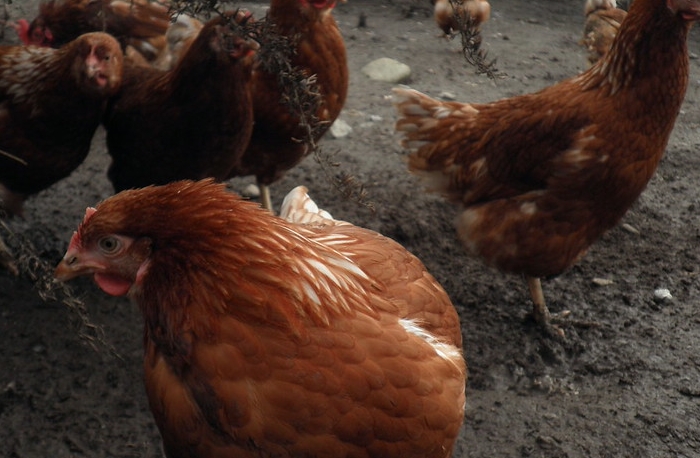By: Autumn Gertz
Image courtesy of Alder Swamp via Flickr Creative Commons
Among focus on the Corona Virus Disease (COVID-19) outbreak originating in the city of Wuhan, Hubei province China, the neighboring province of Hunan is experiencing an outbreak of Avian Influenza among poultry [1-3]. On February 1, the Ministry of Agriculture and Rural Affairs reported that a poultry farm in Shaoyang City lost about half its flock to a highly pathogenic strain of H5N1 [1,2]. Of the 7,850 chickens in the flock, 4,500 died from H5N1 infection [1,2]. As a precautionary measure, 17,828 chicken were culled in a stated “special facility” [1,2,4]. The justification for the cull is the high pathogenicity of the H5N1 strain that was found in the Shaoyang flock [2]. The World Health Organization (WHO) reported that since 2003, 455 people worldwide have died from H5N1 related disease [2,5].
No human cases of H5N1, related to this event or otherwise, have been reported. However, a human case of H9N2 Avian Influenza was reported on February 7 in Hong Kong [6]. This case is a seven-year-old boy with underlying illness who presented with a cough, runny nose, and fever [6]. The Center for Health Protection confirmed it was H9N2 Avian Influenza through a nasal swab and believe it is an isolated case [6]. Contacts, including family and medical staff, have been put under medical observation [6]. The boy had visited his grandparents, who have chickens, but is reported to have had no direct contact with the birds [6]. The most recent H9N2 case in Hong Kong was in 2013, and in total, there have only been eight cases recorded [6]. An additional outbreak of H5N6 was reported, on February 10, in southwestern Sichuan Province [7]. This strain is also highly pathogenic and killed 1,840 birds in the affected flock [7]. The remaining 657 birds on the poultry farm have been culled [7].
Avian Influenza, commonly referred to as “bird flu” is a type of influenza that causes severe respiratory disease in birds [5]. H5N1, the strain included in the Shaoyang City outbreak, has a mortality rate of 60% in humans [5]. Zoonotic transfer from birds to humans is rare but occurs when humans have close contact with either alive or dead infected birds, or H5N1 contaminated environments [5]. A common mechanism of zoonotic transfer in the past has been home slaughter and subsequent handling of the bird prior to cooking [5]. Proper cooking temperatures are high enough to kill the virus, meaning consumption can be safe with correct preparation practices [5]. Once a person is infected with H5N1, person-to-person transmission is uncommon, limited, and inefficient [5,8]. However, given the high mortality rate, and constant genetic changes of influenza virus, H5N1 still possess a large threat to humans [5].
Early symptoms of illness in humans include abdominal pain, chest pain and diarrhea [5]. Other symptoms include those similar to other influenza illness including fever, malaise, cough, sore throat, and muscle aches [5]. Serious disease can also develop and presents with difficulty breathing or shortness of breath, pneumonia, Acute Respiratory Distress Syndrome, altered mental status, or seizures [5]. For treatment, seeking intensive care is recommended and the antiviral oseltamivir can help prevent death and severe illness, and should be given in all cases [5]. There is no widespread vaccination, but there are a few candidates that are accepted [5]. Additionally, seasonal influenza vaccination has not been found to protect against H5N1 [5].
Saudi Arabia and Vietnam are also currently experiencing outbreaks of Avian Influenza among poultry populations. In Saudi Arabia, a strain of H5N8 circulated among a poultry farm in central Sudair [9]. 22,700 birds died of the H5N8 infection and the remaining 385,300 of the flock were slaughtered as a precaution [9,10]. The Saudi Agriculture Ministry reported the outbreak on January 30, and the World Organization for Animal Health (OIE) confirmed it on January 31 and reported it out in February 4 [10]. The last report of H5N8 in Saudi Arabia was on July 22, 2018 [9,10]. On February 4, notification of H5N6 among poultry in Vietnam was reported by OIE [11]. In the affected flock, there were 3000 susceptible birds, of which there were 2500 cases and 2200 deaths [11]. The 300 that were infected but did not die were culled [11]. Prior to these cases, the last reported case of H5N6 in Vietnam was on November 15 of 2019 [11]. On February 17, two outbreaks of H5N1 were reported by OIE also in Vietnam [12]. These two outbreaks consisted of 190 and 500 cases respectively, and the flocks were both culled [12]. Prime Minister Nguyen Xuan Phuc has ordered cities and provinces to strengthen control and preventive measures against Avian Influenza on poultry farms, to mitigate potential transfer to humans [13]. This is especially important now given the threat and increasing number of COVID-19 cases in the area [13]. As COVID-19 continues to spread through China, Asian, and the world at large, it will be important to monitor each of these Avian Influenza strains and see if more local birds are infected, or if any human cases develop from the strains affecting these poultry farms.
References
[1] https://www.agriculture.com/markets/newswire/china-reports-h5n1-bird-flu-outbreak-in-hunan-province
[3] https://promedmail.org/promed-post/?id=20200202.6945785
[5] https://www.who.int/influenza/human_animal_interface/avian_influenza/h5n1_research/faqs/en/
[8] https://www.cdc.gov/flu/avianflu/avian-in-humans.htm
[9] https://wkzo.com/news/articles/2020/feb/04/saudi-arabia-reports-h5n8-bird-flu-on-farm-oie/981531/?refer-section=health [10]https://www.oie.int/wahis_2/public/wahid.php/Reviewreport/Review?page_refer=MapFullEventReport&reportid=33155
[13]https://en.vietnamplus.vn/pm-orders-attention-to-bird-flu-fight/168211.vnp


